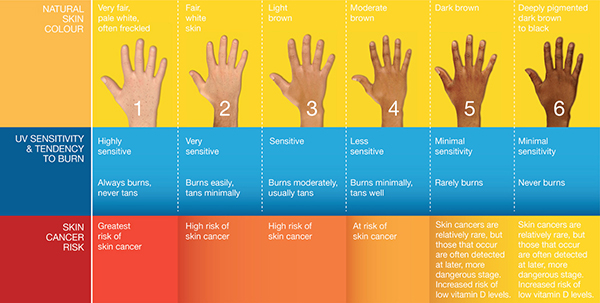Skin Cancer Risks
Are you at risk of skin cancer? Try the skin cancer risk assessment questionnaire below.
Do you have:
• Fair skin that can burn easily
• Red hair or blue eyes
• Previous episodes of sunburn
• Previous frequent sun exposure
• An outdoor job
• An outdoor sport or hobby
• Lots of moles
• A mole that has changed
• A skin spot that bleeds easily or is tender
• A personal or family history of skin cancer
• A lowered immune system, such as taking immunosuppressant medication
If you answered yes to any of the questions then you have a higher risk for skin cancer than people with low risk factors and should consider having a professional skin cancer examination with us.
Skin Type & Sensitivity to Sunburn
Anyone can develop skin cancer, although people with certain types of skin are at greater risk for developing sun damage and skin cancer. Your skin type (phototype) is one of the main factors in your risk for skin cancer, and is based on how your skin reacts to UV light. There are six skin phototypes, going from light to dark, with Type I being the most sensitive to UV and Type VI being the least sensitive to UV. In general, ppeople with darker skin have more protection against skin cancer because they naturally produce higher concentrations of the UV protection substance called melanin than fair-skinned people. However, all people need to protect their skin, especially in Australia, because the intensity of UV radiation is so strong. In Australia, the intensity of UV light is very high compared to countries in the Northern Hemisphere, this is because the tilt of the earth during summer brings Australia closer to the sun than the equivalent time during the northern hemisphere summer.
Moles
Moles, or naevi, are dense collections of the pigment forming cells called melanocytes. Most people will develop several moles during childhood, some people develop many, and some are born with them. Moles are determined through your genetics as well as your exposure and sensitivity to UV light. Some people have larger moles, often with odd shapes or colours. These are termed atypical, or dysplastic. People who have lots of moles, or atypical moles, are identified as being at higher risk of developing melanoma than people with only a few moles.
Family History
Your genes are inherited from your parents and this will largely determine your skin type as well as your types and number of moles. Accordingly, if any of your immediate family members has had a skin cancer then your risk of developing a skin cancer is likely to be increased. If any of your immediate family has had a melanoma, especially at a young age or if they have had more than one melanoma, or multiple moles, then your risk of developing melanoma is likely to be increased.
Outdoor Workers and Sports People
Outdoor workers receive a higher dose of sun exposure and UV light as well as more frequent exposure than indoor workers. The higher and more frequent dose of UV light causes more damage to the skin which accumulates over time and thereby places people who work outdoors for all or part of the day at higher than average risk of skin cancer. This also applies to people who spend a lot of time outside during their leisure time or playing sport.
Lowered Immune Function
People who have lowered immune function are at increased risk of developing skin cancer. This applies especially to those who take immunosuppressant medications such as after organ transplant to prevent organ rejection, or people with inflammatory diseases such as Rheumatoid Arthritis, or people with infectious disease such as HIV.


